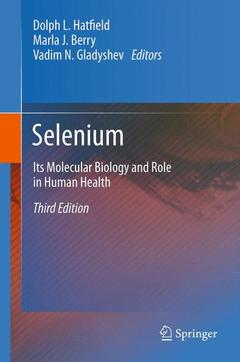Description
Selenium: its molecular biology and role in human health (3rd Ed., 3rd ed. 2012)
Its Molecular Biology and Role in Human Health
Coordinators: Hatfield Dolph L., Berry Marla J., Gladyshev Vadim N.
Language: English
Subjects for Selenium: its molecular biology and role in human health:
Publication date: 01-2014
598 p. · 15.5x23.5 cm · Paperback
Publication date: 12-2011
624 p. · 15.5x23.5 cm · Hardback
Description
/li>Contents
/li>Comment
/li>
Foreword.- Preface.-Dedication.- Acknowledgements.- Chapter 1- History of selenium research.- Part I. Selenocysteine biosynthesis and incorporation into protein.- Chapter 2- Selenocysteine biosynthesis and the replacement of selenocysteine with cysteine in the pathway.- Chapter 3- Molecular mechanism of eukaryotic selenocysteine incorporation.- Chapter 4- SECIS binding proteins regulate the expression of the selenoproteome .- Chapter 5- A ribosomal perspective on the mechanism of selenocysteine incorporation.- Chapter 6- Chemical basis for the use of selenocysteine.- Chapter 7- Evolutionary basis for the use of selenocysteine.- Chapter 8- Selenocysteine lyase: Mechanism, structure and biological role .- Part II. Selenoproteins and selenoproteins in health.- Chapter 9- Selenoproteins and selenoproteomes .- Chapter 10- Structural characterization of mammalian selenoproteins.- Chapter 11- Selenoproteins: Hierarchy, requirements and biomarkers .- Chapter 12- Selenoproteins and the thioredoxin system.- Chapter 13- Selenoproteins of the glutathione peroxidase family.- Chapter 14- Glutathione peroxidase 4.-Chapter 15- Selenoprotein M.- Chapter 16- Selenium transport in mammals: Selenoprotein P and its receptors.-Chapter 17- Selenoproteins in the endoplasmic reticulum.- Chapter 18- Selenoproteins in nervous system development, function and degeneration.- Chapter 19- Selenoproteins in cardiovascular redox pathology.- Chapter 20- Glutathione peroxidase 1 and diabetes.- Chapter 21- Glutathione peroxidase 2 and its role in cancer.- Chapter 22- Selenoprotein N: Its role in disease.- Part III. Selenium and selenoproteins in human health.- Chapter 23- Prostate cancer prevention and the Selenium and Vitamin E Cancer Prevention Trial (SELECT): A selenium perspective.- Chapter 24- Selenium as a cancer preventive agent.- Chapter 25- Selenoproteins harboring a split personality in both preventing and promoting cancer.- Chapter 26- An emerging picture of the biological roles of selenoprotein K .- Chapter 27- Polymorphisms in selenoprotein genes and cancer.- Chapter 28- Schizophrenia, oxidative stress and selenium .- Chapter 29- Control of thyroid hormone activation and inactivation by the iodothyronine deiodinase family of selenoenzymes .- Chapter 30- Role of selenium in HIV/AIDS.- Chapter 31-Seafood selenium in relation to assessments of methylmercury exposure risks.- Chapter 32- Selenium and male reproduction.- Chapter 33- Variations in selenium metabolism in males and females.- Chapter 34- Selenium in Alzheimer’s disease.- Chapter 35- Selenium and inflammation.- Chapter 36- Selenium metabolism in prokaryotes.- Chapter 37-Selenoproteins in parasites.- Chapter 38- Selenium and methionine sulfoxide reduction.- Chapter 39- Inactivation of glutathione peroxidase 1 and peroxiredoxin 2 by peroxides in red blood cells.- Chapter 40- Functional aspects of the genomics of selenoprotein and selenocysteine incorporation machinery genes.- Chapter 41- Selenium: Dietary sources and human requirements.- Chapter 42- Selenium and adverse health conditions of human pregnancy.- Part IV. Mouse models for elucidating the role of selenium and selenoproteins in health.- Chapter 43- Mouse models for glutathione peroxidase 4 (GPx4).- Chapter 44- Mouse models that target removal or over-expression of the selenocysteine tRNA[Ser]Sec gene to elucidate the role of selenoproteins in health and development.- Chapter 45-Selenoproteins in skeletal development and disease: Lessons from Trsp deletion in murine bone and cartilage progenitor cells
Provides an overview of the health benefits of Selenium
Brings the research on selenium up-to-date
Explains how selenium becomes a protein




